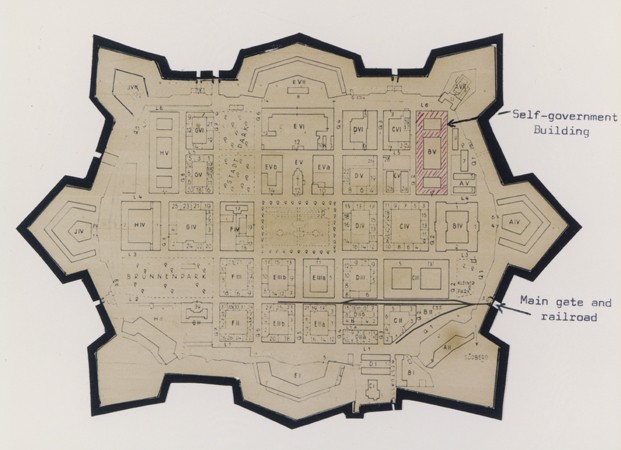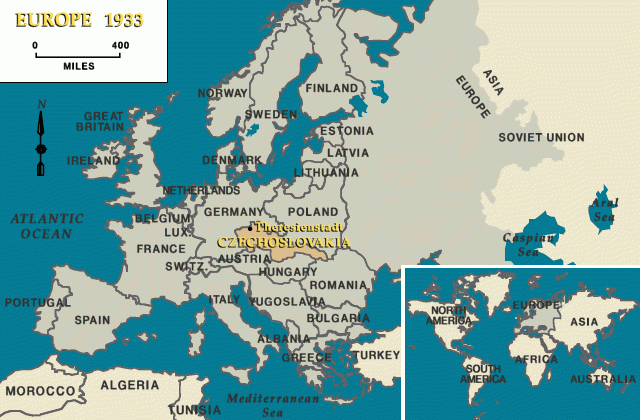
Theresienstadt: Establishment
Background
Austrian Emperor Josef II founded the garrison town of Theresienstadt (today: Terezin) on September 22, 1784, naming it after his mother, Empress Maria Theresa. The garrison town was located approximately one mile southeast of the Bohemian city of Leitmeritz (today: Litomerice). It served as a minor military base first for the Habsburg Monarchy until 1918 and then for the First Czechoslovak Republic until 1938.

German Occupation
When the Germans occupied the Sudetenland in October 1938 following the Munich Agreement of September 29, 1938, the new border included Litomerice within the Greater German Reich and left Theresienstadt in the rump Czecho-Slovak state.
After they occupied the rest of the Czech provinces of Bohemia and Moravia and reorganized them into the Protectorate of Bohemia and Moravia in March 1939, the Germans used the town as a military base until the end of summer 1941. In 1941, the base housed approximately 3,500 soldiers and 3,700 civilians. Virtually all of the employed adults among the civilians worked for the military.
As they planned the first deportations of German, Austrian, and Czech Jews to locations in the east (including Lodz, Riga, Kovno, and Minsk) in early October 1941, the German SS and police decided to convert Theresienstadt into a transit camp-ghetto. In a secret meeting that included Adolf Eichmann, the chief of Reich Security Main Office department IV B 4 (Jews), and SS Captain Hans Günther, the chief of the Prague “Center for Jewish Emigration” (established in the summer of 1939), RSHA chief Reinhard Heydrich expressed his preference for the Theresienstadt site as the primary way-station for the Jews of Bohemia and Moravia. With Hitler's authorization, the SS now intended to deport them to German-occupied Poland, German-occupied Belorussia, and the German-occupied Baltic States.
On October 30, 1941, Heydrich tasked SS First Lieutenant Siegfried Seidl with responsibility for establishing and commanding the planned camp-ghetto. After being briefed by Eichmann and Günther, Seidl negotiated with German military authorities to obtain the site for the SS. The soldiers were transferred and the civilians were relocated. On November 19, Seidl ordered the leaders of the Jewish Religious Community in Prague, including the deputy chairman, Jacob Edelstein, to provide 1,000 members of the community as workers to reconfigure the barracks town into a “settlement” for Jews. On November 24, 1941, at 12:00 noon, the first 1,000 Jews arrived at Theresienstadt.
The Functions of Theresienstadt
RSHA chief Heydrich announced Theresienstadt's function as a “settlement” for certain categories of Jews to SS, State, and Nazi Party functionaries gathered at the Wannsee villa on January 20, 1942, to discuss implementation of the "Final Solution." He stated that Jews residing in Germany and Austria who were 65 years old and above would not be “evacuated” to the east for “labor,” but would be “transferred to a ghetto for the elderly” at Theresienstadt. Also to be "transferred" were German and Austrian Jewish World War I veterans who met at least one of two criteria: severely disabled due to war wounds and/or veterans awarded the Iron Cross 1st Class and above.
Heydrich noted bluntly and cynically the role that Theresienstadt would play for official explanations of Final Solution policy inside the Reich: this “practical solution” would “eliminate at one stroke the many interventions [on behalf of these Jews].” Heydrich later ordered that Theresienstadt was not to accommodate the so-called Mischlinge (Jewish spouses of German non-Jews and the offspring or descendants of such marriages).
After Heydrich's death, a third category of Jews was added to the eligibility list for Theresienstadt: prominent Jews, especially artists, musicians, and other cultural figures whose disappearance in a killing center might provoke inquiry from their communities or even from abroad.
From the beginning, then, Theresienstadt was to serve a double purpose: as transit camp for the Jews of Bohemia and Moravia and as a “retirement community” for those elderly Jews and disabled or highly decorated war veterans. In Nazi propaganda, Theresienstadt was cynically described as a "spa town" where elderly German Jews could "retire" in safety. The SS invented the Theresienstadt fiction primarily for domestic consumption inside Germany and Austria to shore up another fiction about the deportations—that the Reich was deporting its Jewish population to “work” in the East—and to respond specifically to citizens of the Reich who wondered publicly how aged seniors and severely disabled war veterans were to be productive at work in the east.
On occasion, however, when he thought it politically expedient, Himmler used the fiction for foreign consumption as well, such as in his conversation with Italian dictator and Axis ally Benito Mussolini in October 1942, when he described Theresienstadt as a ghetto where the elderly could draw their pensions and benefits, living their lives out according to their own wishes.
Theresienstadt also had a third purpose: it served as a longer-term transit camp for the very German and Austrian Jews German officials claimed its purpose was to protect, for conditions inside the camp-ghetto contributed to the unusual and clearly intended high death rate among its residents.
Critical Thinking Questions
- What was the role of Theresienstadt in the Nazi strategy of deception? How was it different from the majority of concentration camps and ghettos?
- Did other camps have multiple purposes? If so, what were they?
- Euphemisms, mild or indirect words or expressions substituted for ones considered to be too harsh or blunt, can hide dangerous or illegal behavior. What expressions did the Nazis use to disguise their intentions or policies?

